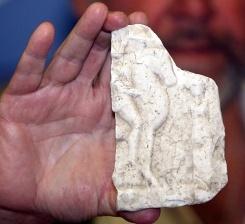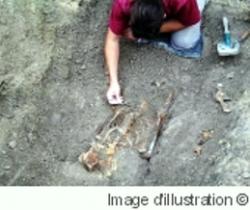- 31 AOÛT
- INDI-UNI : COURS A DISTANCE / ONLINE COURSES
ANTHROPOLOGIE / ANTHROPOLOGY
ARCHEOLOGIE / ARCHAEOLOGY
INSCRIPTION 2011 - 2012 / REGISTRATION 2011 - 2012
- AUTRICHE – Carnuntum - Des archéologues ont découvert les ruines d’une école de gladiateurs sur le site romain de Carnuntum, à une trentaine de kilomètres à l’est de Vienne, a annoncé le parc archéologique mardi. La structure est comparable à celle du Colisée et de l’école de gladiateurs Ludus Magnus à Rome. En plus petit évidement. Nous sommes tout de même loin de la capitale que les Romains appelaient tout simplement Urbs (la ville) L’ampleur du site et l’état de préservation des ruines en font cependant un «site unique au monde», selon le communiqué. Ce site a pu être mis au jour par une équipe internationale d’archéologues au moyen d’un radar. La dépêche ne précise pas à quoi on reconnaît une école de gladiateurs, quand il n’y a plus que des traces de murets au sol. La teneur des objets, peut-être. Il faut rappeler ici que l’Autriche, bien qu’excentrée, a vu la découverte d’un certain nombre de restes antiques. Il existe ainsi un site à visiter sous Vienne. Plus étrange, un sanctuaire d’Isis a été exploré dès le XVIIIe siècle. On y a notamment retrouvé une splendide sculpture pharaonique du Nouvel Empire, été transportée à grands frais il y a quelque deux mille ans.
http://www.tdg.ch/actu/culture/ecole-gladiateurs-decouverte-autriche-2011-08-31
- CANADA - St. Mungo / Glenrose Cannery - A hearing to stop construction of a road through two first nations burial sites in Delta was postponed Tuesday, but it will be heard in B.C. Supreme Court in the coming weeks. The two affected sites - St. Mungo and Glenrose Cannery - are on the south shore of the Fraser River, just east of the Alex Fraser Bridge in North Delta. The St. Mungo site was a large fishing village, and archeological digs have found remains from about 5,000 years ago, the report states. Remains at the Glenrose Cannery site are as old as 8,000 years, and show a settlement where people were dependent on elk and deer, and where seal hunting and fishing also played a role.
http://www.vancouversun.com/technology/First+nations+take+government+court+save+ancient+burial+sites+from+road/5332284/story.html#ixzz1WczLhmKl
- ROYAUME UNI –Gower - Possibly the UK's oldest example of cave art has been discovered in Gower, dating back to the Ice age. Experts say the faint scratchings of a speared reindeer are more than 12,000 years old. Their exact location is being kept secret to protect them from damage. But already they have been the target from a vandal.
VIDEO = http://www.bbc.co.uk/news/uk-wales-14721056
- BULGARIE –  – Perperikon - Professor Nikolay Ovcharov has presented new finds from the Ancient Thracian and medieval fortress of Perperikon proving the existence of an Antiquity period sanctuary that he believes could be the ancient Temple of Dionysus. "The marble reliefs of the Thracian Horseman that we have found during excavations there prove that there was a sanctuary at Perperikon," Ovcharov said . The Thracian Horseman is the conventional term for a recurring motif from the iconography of Paleo-Balkanic mythology during the Roman era, believed to have been supreme deity of Ancient Thrace; he is usually depicted on funeral statues as a horseman slaying a beast with a spear. Ovcharov has been excavating the Ancient Thracian rock city of Perperikon in the Rhodope Mountains for the past few years, and his finds have increasingly proven that Perperikon (also known as Hyperperakion) used to be a crucial urban center during the Middle Ages as well in the Byzantine Empire and the First and Second Bulgarian Empire, and not just in the Antiquity period. His earlier finds also revealed that Perperikon could be a sanctuary of Ancient Greek and Ancient Thracian god Dionysus. "We are currently excavating a very interesting object about the link between the Perperikon acropolis and the sanctuary-palace. I continue to insist that this place was of great importance," Ovcharov said. "We know that in Perperikon, 7000 years ago, there was a rock sanctuary of the sun cult. We have seen these images on ceramics from the Stone-Copper Age, and then this persists throughout the Bronze Age, during which the altars were cut into the sanctuary. The second millennium before Christ was the most important period because this is when the entire system of rock altars, which we are now studying along the mountain range, dates back to," he explained. He added that one of the rock altars is 3 meters in height, and existed for 2000 years, until Christianity was adopted. "This place is a matter of disputes but there is no doubt that this was a sanctuary," Ovcharov said, as cited by BGNES. He believes that the spot in question could be one of the greatest cult sanctuaries of the Antiquity period, the long-sought after Temple of Dionysus, which was also mentioned by Herodotus in his writings. "This temple was as famous as the Temple of Apollo at Delphi. Two Roman historians also write about this temple. However, they don't mention that it was in the Rhodope Mountain. My hypothesis is that this was precisely the Temple of Dionysus," Ovcharov claims. He said the archaeologists took a long time but finally managed to uncover evidence at Perperikon from the Antiquity period – including tiles, coins, and fibulas (brooches) – that indicated intensive life on the spot. Several days ago, the archaeologists found part of marble reliefs of the Thracian Horseman with a goddess welcoming him. The back side of the marble reliefs is not smooth, which leads Ovcharov to believe that it was built into a wall and served as an icon. It was found 4 meters away from the hall with the altar of the suspected ancient sanctuary together with an amulet with an image of the sun. "It is believed that the Thracian Horseman, often called the Thracian Heros, was a personification of all earlier religious beliefs of the Thracians – from the creation of their religion, or that it personified their older gods," Ovcharov explained.
– Perperikon - Professor Nikolay Ovcharov has presented new finds from the Ancient Thracian and medieval fortress of Perperikon proving the existence of an Antiquity period sanctuary that he believes could be the ancient Temple of Dionysus. "The marble reliefs of the Thracian Horseman that we have found during excavations there prove that there was a sanctuary at Perperikon," Ovcharov said . The Thracian Horseman is the conventional term for a recurring motif from the iconography of Paleo-Balkanic mythology during the Roman era, believed to have been supreme deity of Ancient Thrace; he is usually depicted on funeral statues as a horseman slaying a beast with a spear. Ovcharov has been excavating the Ancient Thracian rock city of Perperikon in the Rhodope Mountains for the past few years, and his finds have increasingly proven that Perperikon (also known as Hyperperakion) used to be a crucial urban center during the Middle Ages as well in the Byzantine Empire and the First and Second Bulgarian Empire, and not just in the Antiquity period. His earlier finds also revealed that Perperikon could be a sanctuary of Ancient Greek and Ancient Thracian god Dionysus. "We are currently excavating a very interesting object about the link between the Perperikon acropolis and the sanctuary-palace. I continue to insist that this place was of great importance," Ovcharov said. "We know that in Perperikon, 7000 years ago, there was a rock sanctuary of the sun cult. We have seen these images on ceramics from the Stone-Copper Age, and then this persists throughout the Bronze Age, during which the altars were cut into the sanctuary. The second millennium before Christ was the most important period because this is when the entire system of rock altars, which we are now studying along the mountain range, dates back to," he explained. He added that one of the rock altars is 3 meters in height, and existed for 2000 years, until Christianity was adopted. "This place is a matter of disputes but there is no doubt that this was a sanctuary," Ovcharov said, as cited by BGNES. He believes that the spot in question could be one of the greatest cult sanctuaries of the Antiquity period, the long-sought after Temple of Dionysus, which was also mentioned by Herodotus in his writings. "This temple was as famous as the Temple of Apollo at Delphi. Two Roman historians also write about this temple. However, they don't mention that it was in the Rhodope Mountain. My hypothesis is that this was precisely the Temple of Dionysus," Ovcharov claims. He said the archaeologists took a long time but finally managed to uncover evidence at Perperikon from the Antiquity period – including tiles, coins, and fibulas (brooches) – that indicated intensive life on the spot. Several days ago, the archaeologists found part of marble reliefs of the Thracian Horseman with a goddess welcoming him. The back side of the marble reliefs is not smooth, which leads Ovcharov to believe that it was built into a wall and served as an icon. It was found 4 meters away from the hall with the altar of the suspected ancient sanctuary together with an amulet with an image of the sun. "It is believed that the Thracian Horseman, often called the Thracian Heros, was a personification of all earlier religious beliefs of the Thracians – from the creation of their religion, or that it personified their older gods," Ovcharov explained.
http://www.novinite.com/view_news.php?id=131652
- FRANCE –  Angers - Les fouilles menées par l'Institut national de recherches archéologiques préventives, ont démarré ce lundi matin place Lorraine. « On est au tout début du 1er siècle, sur une voie de sortie au nord-est de la cité antique que nous connaissons bien et dont nous avons un quadrillage précis des rues », indique Jean Brodeur, archéologue. Les archéologues espèrent trouver les traces d'une activité économique ou une place de marché ou un ensemble d'artisans travaillant les métaux et la terre. Le site pourrait également être le prolongement de la nécropole découverte en 1987 place Leclerc.
Angers - Les fouilles menées par l'Institut national de recherches archéologiques préventives, ont démarré ce lundi matin place Lorraine. « On est au tout début du 1er siècle, sur une voie de sortie au nord-est de la cité antique que nous connaissons bien et dont nous avons un quadrillage précis des rues », indique Jean Brodeur, archéologue. Les archéologues espèrent trouver les traces d'une activité économique ou une place de marché ou un ensemble d'artisans travaillant les métaux et la terre. Le site pourrait également être le prolongement de la nécropole découverte en 1987 place Leclerc.
http://www.angers.villactu.fr/fouilles-archeologiques-ont-debute-lorraine-n45366-c0115.html